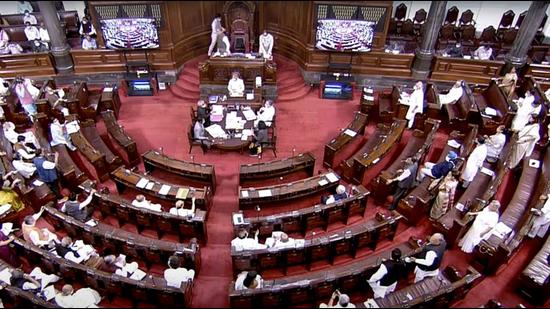For the BJP, the battle in states — with an eye on Rajya Sabha
Of the current 237 seats of the Upper House of Parliament, the BJP has 95 seats while its broader National Democratic Alliance has 110 seats—just nine seats short of the majority mark
For the Bharatiya Janata Party (BJP), the upcoming state assembly elections are not just an opportunity to consolidate and expand its footprint across southern and eastern India, but also ramp up its strength in the Rajya Sabha, where it is still in minority.

As many as 22 Rajya Sabha seats in these states—all held by non-BJP parties—will be up for grabs between the state election results and May 2024, when the term of the current Lok Sabha will be over. West Bengal, where the BJP is pitted against Mamata Banerjee’s Trinamool Congress, accounts for half of these seats. The BJP has a strong presence in Bengal and won as many as 18 Lok Sabha seats in the 2019 election. But it has never had a Rajya Sabha member from the state.
Whether it wins or not, if it gets at least 43 seats in the assembly, which is highly likely, the BJP can elect its first Rajya Sabha MP from West Bengal in August 2023—when six seats from Bengal will face biennial elections. And any gain in Bengal for the BJP might lead to losses for Mamata Banerjee’s Trinamool Congress that holds five of those six seats.
Also Read | HT Interview: ‘BJP provided road map for Sonar Bangla,’ says Amit Shah
Of the current 237 seats of the Upper House of Parliament, the BJP has 95 seats while its broader National Democratic Alliance has 110 seats—just nine seats short of the majority mark. With the support of friendly parties such as the All India Anna Dravida Munnetra Kazhagam (AIADMK) (nine MPs), Biju Janata Dal (nine MPs) and Yuvajana Sramika Rythu Congress Party (six MPs), clearing bills in the Upper House has become smoother for the government in this term than it was in its first term, but the absence of a direct majority means more political work and negotiations with smaller forces.
In the past two years, after it retained power in the 2019 elections, the BJP has rapidly improved its position in the Upper House. It had just 73 seats before the 2019 national elections. The Congress has less than 50 seats for the first time in the Upper House.
Two Rajya Sabha seats from Assam, currently held by the Congress, will go to polls early next year. The BJP might get an opportunity to grab at least one of them, if not both, if it does well in the assembly polls.
Three Rajya Sabha seats from Kerala and six from Tamil Nadu will go to the polls between now and May 2024. While the BJP’s prospects in Kerala are rather limited, in Tamil Nadu, it has a partnership with the AIADMK. But in both the southern states, the BJP’s chances of getting a Rajya Sabha seat are minimal. It is the Congress which can hope to gain here, but this will be contingent on its performance in Kerala and its negotiations with the Dravida Munnetra Kazhagam in Tamil Nadu, provided the opposition alliance wins.
India’s bicameral Parliament—inspired from the British system—has the Lok Sabha and the Rajya Sabha. The Upper House enjoys nearly all the power of Lok Sabha except that it can’t veto a budget or any money bill.
As India’s federal laws need the approval of both Lok Sabha and the Rajya Sabha, the Upper House—although not directly elected by the public—can reject a bill or seek amendments. Also, a legislation introduced in Rajya Sabha has no shelf life and will remain alive till it has been passed by the House.
While Lok Sabha members are elected directly by the voters, the Rajya Sabha members come through a complex process of proportional representation and by votes of the MLAs of their respective states. The calculation is: (total number of MLAs of the state ÷ no of seats going to poll in the state +1) +1.
Each MLA ranks candidates according to his or her preference. If a candidate gets the minimum requisite votes, he or she would be elected. But if in a contest, a candidate fails to get the requisite votes from the first preference of the voters, the second preference votes would be counted.
The strength of Rajya Sabha is 245, out of which 233 are elected from the states and union territories. The remaining 12 members are nominated by the President. The number of Rajya Sabha MPs will depend of the size of the population of that state. Uttar Pradesh, the most populous state of India, sends 31 MPs to the Upper House, while Arunachal Pradesh has just one seat.
Get Current Updates on India News, Lok Sabha Election 2024 live, Infosys Q4 Results Live, Elections 2024, Election 2024 Date along with Latest News and Top Headlines from India and around the world.




